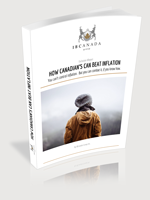Being an adult comes with making tough decisions.
Tough decisions require you to elevate from between the primary choice of good and bad and into the tenacious decisions between better and best. Economic choice, such as how much more I prefer money in my pocket compared to spending my money, is a primary decision.
A more tenacious choice would be between the logical or emotional benefit I receive by spending my money now compared to the logical or emotional dissatisfaction when I realize I gave up the return forever when that money leaves my pocket. The idea of that lost return on the money I spend on a single and seemingly inconsequential decision may seem trivial in the moment, but those who have created wealth have long known the compound effect of the sum of the lifetime of their decisions, not just in that single moment.
Deciding to replace bad financial habits with wealth-creating habits is an admirable one, but it must be followed up with more great decisions to change your mindset.
The first time I heard my friend and fellow IBCanda Group founder Wayne Durksen say that “cash and capital are not synonymous,” I realized just how profound that statement was. Regarding your savings as a bourgeoning pool of long-term capital sets new behaviour to how you treat that savings. Instead of seeing your savings as something temporary, we regard capital as enduring and permanent. The idea of saving, growing, and protecting your capital is important enough to consider options other than a high interest savings account offered by financial institutions. Saving tax on the growth of that capital becomes a priority beyond the limitations of a Tax Free Savings Account.
The discovery process to find the best financial vehicle to perform the function of storing capital in Canada inexorably leads a person to realize that a properly designed, dividend-paying, participating, tax-exempt whole life insurance contract is the best way perform this function. In short, the best process of storing capital can be accomplished through the Infinite Banking Concept, using the platform of such an insurance contract.
That discovery process must be facilitated by certified and qualified specialists in order to get correct information to make an informed decision. Engaging the services of an Authorized Infinite Banking Concept Practitioner, who is trained and vetted by the Nelson Nash Institute, is necessary in this process of understanding the Infinite Banking Concept (IBC). To be clear, IBC should not be construed as an investment, or a real financial institution, or a gimmick. It is a tried-and-true asset that has survived every conceivable economic calamity and government interventionist scheme. Life insurance contracts predate the Income Tax Act (the Act) by more than 70 years and continues to enjoy preferential treatment in the Canadian legal and tax regime. There may be insurance agents who claim to understand the process, but without engaging with an Authorized IBC Practitioner, you’re leaving the proper policy structure and best use of the contract up to chance.
Chance is never an appropriate option in proper financial planning.
One of the decisions an Authorized Practitioner is likely to guide you through is the choice of the insurance company to place a contract with. There are only a handful of companies in Canada that offer the specific type of tax-exempt contract that is appropriate to use for the purposes of implementing IBC. Out of the four companies offering an appropriate contract, one is a mutually owned company (owned by the policyholders) and three are stock companies (shares are listed on a stock exchange). It’s important to remember that designing a policy using the right contract is the most important element IBC, there are pros and cons to deal with the unique features and benefits of each contract offered by each different company. The complex job of an Authorized Practitioner is to help easily guide you through these choices.
As we consider the benefits of each different type of contract, we arrive at the question whether to use a mutual insurance company or a stock insurance company. It really boils down to the type of contract offered by each of the companies instead of the differences between a mutual or stock company, which we shall explore here further. This question should be approached agnostically, and based on the details of your individual situation, including but not limited to factors such as your age and health status, the deposit amounts and duration, etc.
Before we can answer the question whether to use a mutual or stock insurance company, and before we look at the differences of the contracts each type of company offers, we first must understand why Nelson Nash, the creator of IBC, preferred mutual over stock companies. He did leave some clues about using stock companies, such as:
- On page 42 of the 5th edition of Becoming Your Own Banker, Nelson states, “There are some exceptions to this requirement [using a mutual company]. There are some stock companies that have dividend-paying policies.”
- On pages 23 and 41 of the 2nd edition of The Case for IBC, co-authors Nelson Nash, Carlos Lara, and Dr Robert Murphy write that it is preferable to use a mutual company, but not necessary.
It is clear that Nelson’s intent was not to be myopic or pigeon-hole a client into a specific company.
This makes IBC consistent with the tenets of true financial planning. That is, being guided by the facts and circumstances of each client’s situation and allowing that guide the decision instead of being a product gimmick as some incorrectly assume IBC to be. Acting in the best interests of the client was paramount to doing the right thing in Nelson’s mind. After all, if the only solution you have is a hammer, every problem becomes a nail.
Let’s start this analysis with some basics of a “dividend-paying, participating, tax-exempt whole life insurance contract” that can be correctly used to perform the function of IBC in Canada.
Cash Value
These contracts are designed to accumulate cash value, which is built from a combination of the base premiums of the contract and additional discretionary overcontributions.
Consider that the base premiums of a whole life contract work similar to a mortgage, where payments are a blend of principal and interest. In an insurance contract, base premium deposits are a blend of cash surrender value and the costs of setting up the insurance contract.
Every single premium made essentially attributes a developing equity position in the contract. Additional overcontributions go straight to cash surrender value without the drag of insurance contract costs but are reasonably limited by Act.
Cash surrender value in a properly designed insurance contract has a high collateral value, which is a basic feature of IBC. Working with an Authorized Practitioner will help you determine the best way to leverage against the cash values of these policies.
Policies are Tax-Exempt
As insurance contracts were made available in Canada 70 years prior to the Temporary War Measures and Income Tax Act, they have preferential tax treatment as described in Section 148 of the Act. The status of contracts being “tax-exempt” make insurance the preferred asset class to perform the function of IBC. This status includes the tax-exempt, predictable compounding returns of the policy (as far as the returns remain in the contract), plus the correctly structured tax-exempt credit facilities, plus the total tax-exempt distributions on the death of the insured person. The Act clearly defines the calculation of the overcontribution limit, which is unique to every policy and can be significant with the proper design.
Anything considered a withdrawal from a policy may give rise to a tax consequence. Therefore, an abundance of cautionary planning should be made before making any kind of withdrawal to ensure surprises are left to birthday parties and not during a call from your accountant.
Dividends
As the cash surrender value accumulates in the policy, it attracts a return that is described as “dividends.” To be clear, these are not true “dividends” as defined in subsection 89 (1) of the Act, but are considered a refund of premiums to the contract, and are therefore tax-exempt as they remain in the contract as described in Section 148 of the Act. They are the investment experience of the insurance company as they manage the funds in the participating account, referred to as the “Participating Pool” or “Participating Block.” The dividend calculation includes the experience from the investment activities, the mortality costs, expenses, and lapse rates. These are best described as a surplus on the investment experience of the insurance company on its participating block. The net or “divisible” surplus is then distributed to the policyholders.
It’s important to recognize that the calculations on the returns for the participating policies are the same regardless of if the company is a mutual or stock company. There is no enhancement to the participating block from the general operations of the insurance company.
Dean Erickson, Individual Life Sales Vice President of Equitable Life of Canada, suggests:
“As for the question surrounding the other divisions of the company and the benefit to the participating account, it has value but no direct calculation. Participating Dividends for all companies include mortality, expenses, lapse rates and interest earned on the participating portfolio. There is a benefit to the company and all divisions being run well, but other divisions do not contribute to the participating calculation.”
In essence, the block with both a stock company and a mutual company is an insulated entity, protected from the misfortunes to the other business an insurance company does. Obviously, this would be a concern to those who recall the calamity of the 2008 financial crisis, but the returns of the participating blocks in every company during that time were stable and basically unchanged over that period despite major financial institutions suffering tremendous losses.
Knowing that your capital will be there when you need it is a crucial ingredient to IBC. These contracts also include guarantees on the capital you have inside the contract.
Paid-up Additions
The preferred method of receiving these dividends in the case with IBC is to purchase “paid-up additions” (PUA). Those familiar with Becoming Your Own Banker would remember that Nelson referred to PUA as a rider to the base contract. In Canada, PUA is attached to the contract as a base feature and is the standard method to receive dividends. In this manner, cash surrender value of the policy is able to grow exponentially as compared to other ways to determine the payment of the dividend.
Term Riders
In our look under the hood on these insurance contracts, another option of policy design is the use of term insurance riders on the contract. A rider is an addition to the policy that usually adds a benefit of some kind in consideration of a premium. A term rider can be used in moderation to increase the total death benefit, which can increase the cash deposits in the contract. This has only been made available in Canada recently but is as described in the 2nd edition on page 76 of The Case for IBC, and as allowed in Canada under Regulation 310 of the Act. Due care and caution should be exercised by both the advisor and the client to ensure that these term riders are reasonable to the overall death benefit of the contract, lest CRA determine that the policy should be described as a term contract and not a whole life contract, resulting in the fatal application of a deemed disposition under the General Anti-Avoidance Rules (GAAR).
Participating
The main difference in the distribution of dividends between a mutual or stock company lies in the involvement of the shareholders, and the overall differences in the management of the companies.
One might logically construe that a private company is going to make management decisions based on a longer term compared to the quarterly stock performance, but such comparisons while logical, remain anecdotal.
It is correct that a portion of the profit surplus calculated for the participating block in a stock company may be paid to shareholders. They are legislatively limited to 2.5% of the overall policy dividends with the remaining paid to the participating block. In some cases, stock insurance companies can require the participating block to make a “permanent contribution to surplus” which is retained by the participating fund forever. This contribution comes off the top of the dividend first, and then is split within the legislative guidelines. Not all stock companies calculate the permanent contribution, and not all companies offer shareholders a stake in the participating block, so it’s even more crucial that one deals with a Canadian Authorized IBC Practitioner to fully answer such relevant details, as policy design can avoid these consequences.
So, if mutual companies don’t calculate the profit from the other lines of business, what does the word participating really mean?
Participating policies do not participate in the overall operations of the insurance company regardless of their ownership structure. It is limited to participation in the profitability of the block of policies. That is, if the insurance company benefits from lower mortality within the participating block of policies, that increases the investment experience, hence an increase to the surplus, and an increase to the dividend received. In their book Paycheques and Playcheques, authors Tom Hegna, Steve Tate, and Rob Gawthrop refer to this unique asset class as “mortality credits.” Participating whole life insurance contracts are the only vehicle to provide Canadians the opportunity to participate in this asset class.
With the possession of such facts, we can now more aptly review the competitive market of the mutual and stock insurance companies and make some qualitative decisions.
Many Authorized Practitioners favour mutual insurance companies and refer to page 80 of Nelson’s book Building Your Warehouse of Wealth, where he states, “mutual companies giving you a share of the entire profits of the company via dividends.” His primary reasoning was based in the American laws governing insurance companies, and specifically, the ability for mutual companies to share a portion of their surplus with their owners, the policyholders. As mentioned previously, the total surplus of an insurance company includes an amount set aside for future contingencies and other expense factors, and the remaining amount is called the “divisible surplus” that is divided between the participating policies in the form of a dividend. By law, American insurance companies must distribute at least a portion of the total surplus back to the policyholders as a divisible surplus, and also do so to compete in the market.
In Canada, mutual insurance companies isolate their surplus from their other products as equity on their financial statements and invest back into their growth. On the very rare occasion, mutual companies can elect to make a special dividend, which has happened twice in the last 100 years in the case of Equitable Life. Otherwise, ownership rights are not tradeable, exchangeable, or have any other intrinsic benefits and expire when the underlying policies terminate. In the event the mutual company decides to become a public company, that built up equity transfers into shareholder equity as happened in the late 1990’s when most insurance companies took the opportunity to go public.
Stephen Krupitz, FSA, FCIA, AVP Advanced Sales and Actuarial Consultant at Manulife Financial, comments on page 40 of the 10th edition of the Canadian Taxation of Life Insurance that:
“If the insurance company is a mutual company, it’s participating policyholders are nominally the owners of the company although such ownership is primarily academic in nature as the ownership rights are not fungible unless that company demutualizes.”
The largest remaining mutual company in Canada, Equitable Life, has repeatedly suggested that they are not considering demutualizing now or in the future.
I won’t take concrete position on whether it is nobler to place the insurance contract with a mutual or stock company in Canada. Like any good Certified Financial Planner, I will take the position of “it depends.” That means that the subjective facts of the client’s situation trump any noble position, and a fiduciary responsibility can be allowed to emerge over any personal preferences the Authorized Practitioner may have. Both stock companies and mutual companies offer unique benefits depending on the client’s situation, which may include factors such as insurability, amounts and durations of deposits, flexibility on making additional deposits, and many others. Despite any preference to use mutual company, it is not always feasible to do so in the Canadian story of IBC compared to the US story of IBC, especially given the short bench of companies in the Canadian marketplace.
At the end of the day, both mutual and stock companies can offer value to the functionality of IBC in deep and meaningful ways. There is no clear winner here and the decision really lands on two factors:
- Your unique situation
- The ability for your Authorized Practitioner to design a contract with the maximum flexibility that reflects your unique situation
The choice between a mutual company and a stock company is really a combination of the hard logical facts and soft emotional facts as you engage with someone facilitate your journey to create, grow and protect your capital.
When considering IBC in your own life, I would advise that you use an Authorized IBC Practitioner to guide you on that journey. The Infinite Banking Canada Group is not the only home to Canadian Practitioners but is the largest independent group of Authorized IBC practitioners in the country. To find an Authorized IBC Practitioner that works with the IBCanada Group, please visit www.ibcanadagroup.ca, or visit the Nelson Nash Institute – the centre for Infinite Banking Concept in North America – at https://infinitebanking.org




